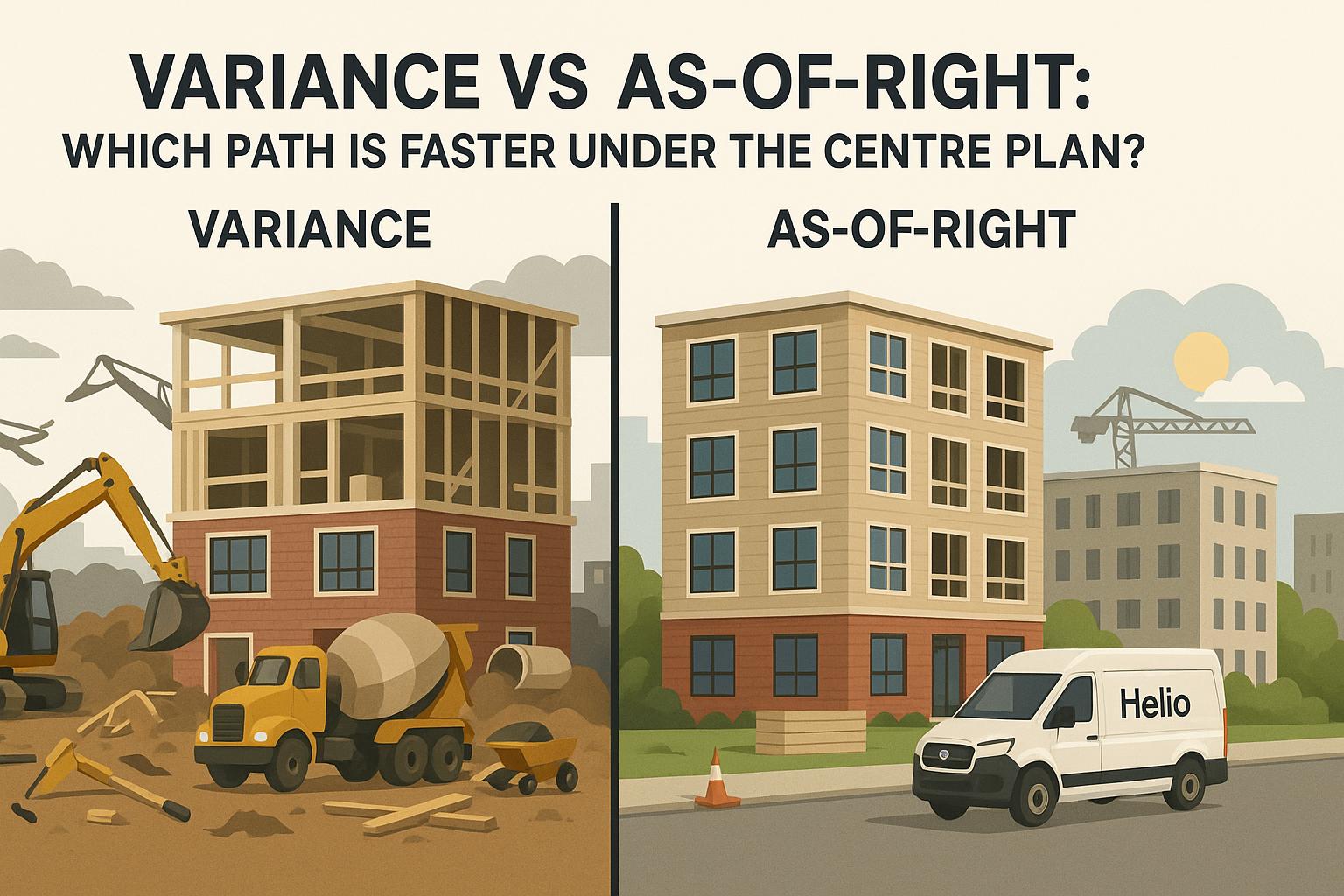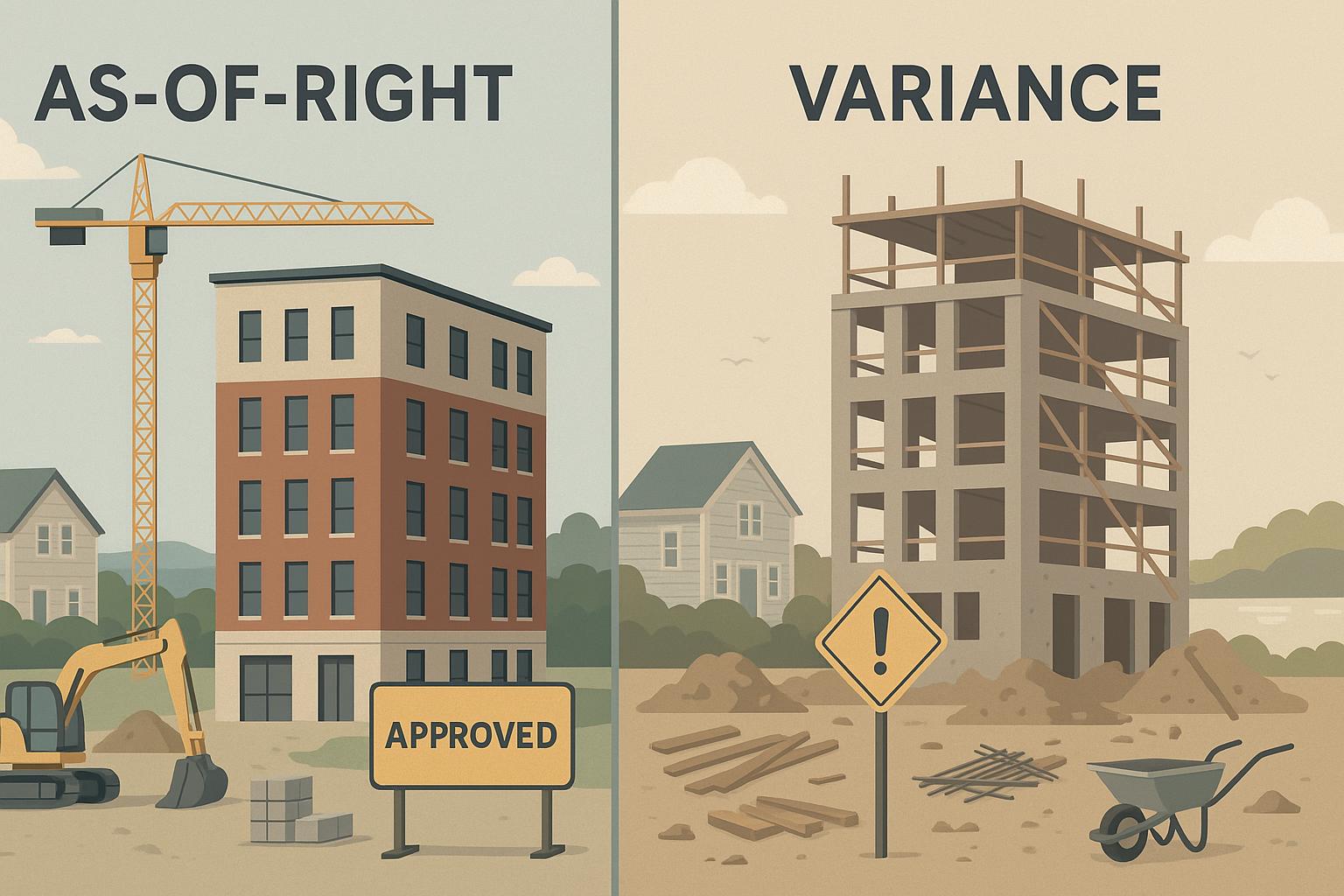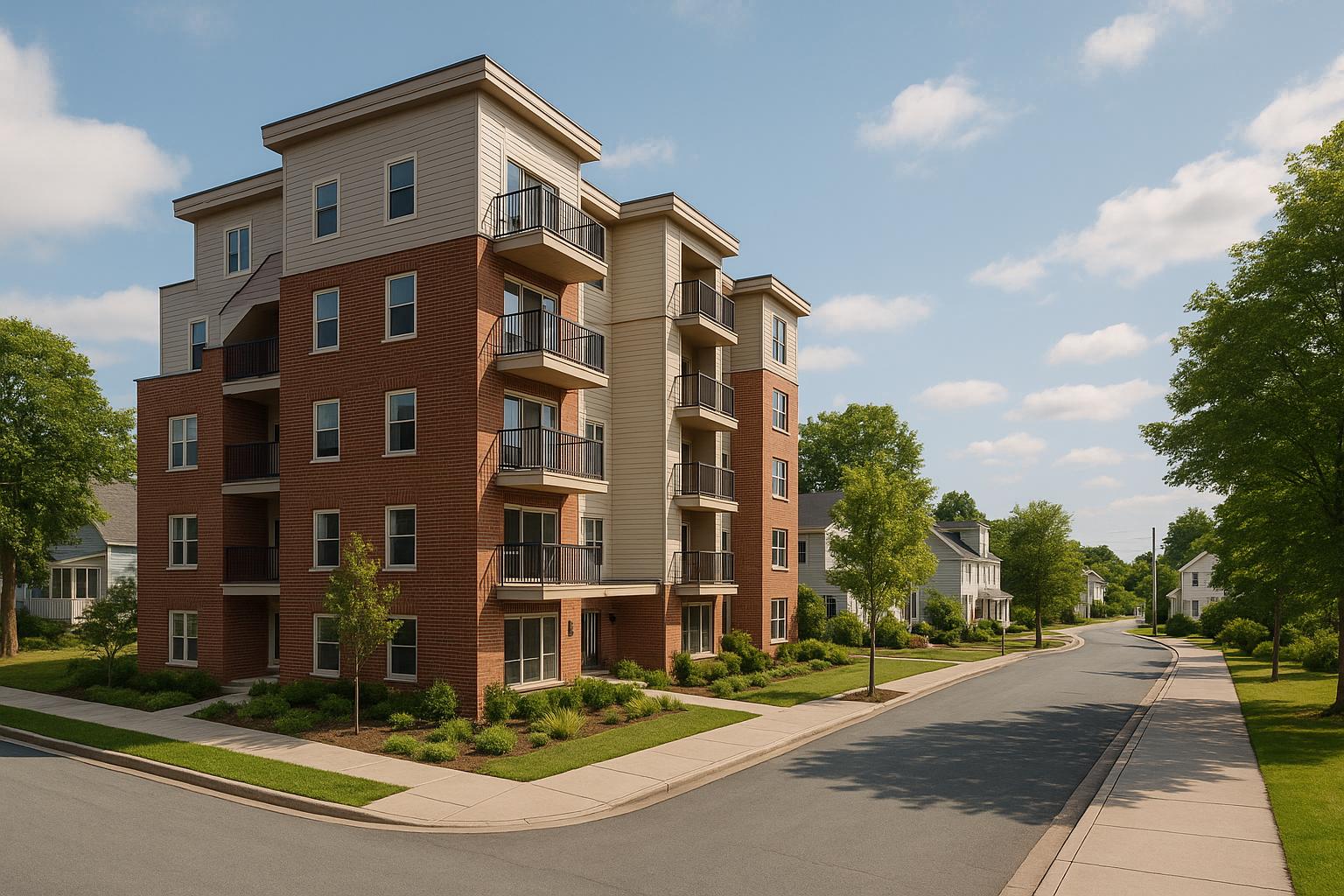Thinking about building a home in Nova Scotia? Here's what you need to know upfront:
- Cost per square foot: Starts at $168 for standard builds, with custom luxury homes ranging from $275–$555.
- Land purchase: Urban areas like Halifax are pricier than rural regions. Expect around $65,000 for a 1-acre serviced lot in Annapolis Valley.
- Main construction costs: For a 1,800 sq.ft standard home, the total is about $302,400.
- Design and permits: Allocate $12,500–$32,000 for planning and permits.
- Utility connections: Budget $10,000–$20,000 for water, electrical, and septic systems.
- Contingency fund: Set aside 10% of your total budget for unexpected costs.
Quick Breakdown of Total Costs for an 1,800 sq.ft Home:
| Category | Estimated Cost |
|---|---|
| Land Purchase | $65,000 |
| Site Preparation | $22,500 |
| Building Permits | $3,200 |
| Design & Engineering | $12,500 |
| Foundation | $42,000 |
| Main Construction | $302,400 |
| Utility Connections | $18,500 |
| Exterior Work | $24,000 |
| Contingency Fund | $49,100 |
| Total | $539,200 |
Tips to Save Money:
- Use fixed-price contracts to avoid cost overruns.
- Build during the off-peak season (October–March) for better rates.
- Choose standard finishes and simple designs to cut costs by $45,000–$60,000.
Building in Nova Scotia offers affordability compared to other provinces and potential equity gains. Start with a solid plan, a realistic budget, and consider fixed-price contracts for a smoother, stress-free experience.
New Construction in Halifax Part One. How Much Does It Cost? How to Select a Builder?
Land and Site Costs
Planning for land acquisition and site preparation is crucial, as costs can vary greatly depending on location and property features. Below, you'll find details on regional land prices, preparation tasks, and utility setup expenses.
Land Prices by Region
In Nova Scotia, land prices differ significantly between urban and rural areas. For instance, urban zones like the Halifax Urban Core generally come with higher price tags due to their proximity to amenities and infrastructure. On the other hand, rural areas often provide more budget-friendly options. To get accurate pricing, explore local markets and consult real estate professionals.
Site Preparation Requirements
Be prepared for these potential expenses:
- Land transfer taxes, which vary by municipality
- Surveying and legal fees, necessary for title registration
- Site work, such as clearing trees, removing rocks, grading, or excavation
Utility Setup Costs
Connecting your property to essential utilities is another major expense to account for. Whether you're tying into municipal services or opting for off-grid solutions like a well and septic system, costs typically range from $10,000 to $20,000. The final amount will depend on factors like soil conditions, the distance to existing utility lines, and any additional infrastructure needed.
Pre-Construction Planning Costs
Having a well-thought-out pre-construction budget helps you stay on top of your overall project expenses. Typically, pre-construction costs account for 5–15% of the total project budget. These costs serve as the bridge between initial planning and the actual construction expenses.
Building Permit Costs
Here’s the 2025 fee structure for building permits:
| Construction Value | Permit Fee |
|---|---|
| First $25,000 | $200 base fee |
| $25,001–$100,000 | $7.50 per $1,000 |
| Over $100,000 | $6.50 per $1,000 |
For example, a $400,000 construction project in HRM would result in permit fees of approximately $2,762.50.
Design and Planning Fees
Design-related expenses are another critical factor in your budget. Professional design services can significantly influence the success of your project:
- Stock house plans: $2,000 to $4,000, with additional costs for modifications
- Custom architectural design: 5–8% of construction costs for standard homes
- Engineering reports: $1,500 to $3,000 for basic structural analysis
- Site plan development: $800 to $1,500
- Energy efficiency compliance documents: $500 to $1,000
For a $400,000 project, you should allocate approximately $20,000 to $32,000 for all design-related services.
Permit Processing Times
In Nova Scotia, getting permits approved typically takes 1–3 months, depending on several factors:
- Incomplete documentation can delay approval by 2–3 weeks.
- Zoning requirements may add another 4–6 weeks.
- Applications submitted during peak season (May–September) often take longer.
- Permits in rural areas are generally processed faster than in HRM.
To avoid delays, ensure all required documents are submitted and consider applying during the off-peak season (October–March). Delays in processing can lead to higher construction financing costs due to increased carrying expenses.
Main Construction Expenses
Building costs in Nova Scotia are influenced by market trends and inflation, which can shift over time.
Price Per Square Foot
In 2025, the cost of building a home varies depending on the type of construction. Standard homes range from $168 to $185 per square foot, while custom luxury homes fall between $275 and $555 per square foot.
Here’s a breakdown based on home size:
| Home Size (sq ft) | Standard Build | Custom Luxury Build |
|---|---|---|
| 1,500 | $252,000–$277,500 | $412,500–$832,500 |
| 2,000 | $336,000–$370,000 | $550,000–$1,110,000 |
| 2,500 | $420,000–$462,500 | $687,500–$1,387,500 |
These estimates provide a baseline for understanding how construction costs are distributed.
Building Stage Costs
Construction budgets are typically divided across key stages of the building process. Here’s a general guide:
| Construction Phase | Percentage of Budget | Included Work |
|---|---|---|
| Foundation | 15–20% | Excavation, footings, foundation walls, waterproofing |
| Framing | 20–25% | Lumber, trusses, sheathing, labour |
| Exterior Finishing | 15–20% | Roofing, siding, windows, doors |
| Interior Systems | 30–35% | Electrical, plumbing, HVAC, insulation |
| Interior Finishing | 20–25% | Drywall, flooring, cabinets, trim |
These percentages can shift depending on design complexity or the inclusion of high-end features.
Materials and Finishing Costs
The materials and finishes you choose can have a major impact on your overall costs. Below is an overview of some common options and their price ranges:
Exterior Finishes
- Vinyl siding: $8–$12/sq ft
- Fibre cement: $12–$18/sq ft
- Natural stone veneer: $35–$50/sq ft
Flooring
- Laminate: $4–$8/sq ft
- Engineered hardwood: $12–$20/sq ft
- Porcelain tile: $15–$25/sq ft
Kitchen Finishes
- Basic cabinets and countertops: $15,000–$25,000
- Mid-range materials: $25,000–$40,000
- Premium finishes: $40,000–$75,000
Choosing premium materials can increase your overall per-square-foot cost by 25–40%. To keep costs manageable while maintaining quality, focus on upgrading finishes in key areas such as kitchens and bathrooms.
sbb-itb-16b8a48
Financial Planning and Extra Costs
Construction Loan Basics
Construction loans work differently from standard mortgages. Instead of receiving the full amount upfront, funds are disbursed in stages, and you only pay interest on the money already released. However, these loans often come with higher interest rates and additional fees, so it's crucial to include these in your budget.
Emergency Fund Planning
After understanding your loan structure, it's time to prepare for unexpected expenses. Setting aside a contingency fund - about 10% of your total budget - is critical for covering surprises like unforeseen site issues or changes in material costs.
"My Budget Exploded. I thought I'd accounted for everything... then one 'surprise' cost after another. Now I'm $78,000 beyond my plan with no end in sight." – John D., First-Time Developer [2]
For instance, if your project costs $500,000, having an extra $50,000 on hand can save you from financial stress. This safety net can help you handle unexpected situations without derailing your project.
Additional Project Costs
Don't forget to account for these often-overlooked expenses:
| Cost Category | Typical Range | Notes |
|---|---|---|
| Builder's Risk Insurance | $1,500–3,000 | Required by lenders |
| Temporary Housing | $1,800–2,500/month | Needed while construction is ongoing |
| Storage Fees | $150–300/month | To store your belongings |
| Utility Deposits | $500–1,500 | Costs for connecting utilities |
Choosing a fixed-price contract with your builder can help you avoid budget surprises and keep costs predictable [2].
Sample Budget: 1,800 Sq.Ft House Build
Here’s a detailed budget breakdown for building a standard 1,800 sq.ft home in Nova Scotia in 2025.
Cost Breakdown by Category
| Budget Category | Estimated Cost | Details |
|---|---|---|
| Land Purchase | $65,000 | 1-acre serviced lot in Annapolis Valley |
| Site Preparation | $22,500 | Clearing, grading, and driveway |
| Building Permits | $3,200 | Municipal permits and inspections |
| Design & Engineering | $12,500 | Stock plan modifications and engineering review |
| Foundation | $42,000 | Full basement with 8-foot ceiling |
| Main Construction | $302,400 | $168/sq.ft for 1,800 sq.ft |
| Utility Connections | $18,500 | Water, electrical, and septic system |
| Exterior Work | $24,000 | Basic landscaping, deck, and walkways |
| Contingency Fund | $49,100 | About 10% of total project costs |
| Total Project Cost | $539,200 | Complete turnkey price |
This estimate reflects the current Nova Scotia market rate of $168 per square foot for standard builds. It includes an open-concept living area, three bedrooms, two full bathrooms, a single-car attached garage, a standard kitchen with quartz countertops, vinyl siding, asphalt shingles, a heat pump system, and a standard electrical package.
Tips for Reducing Costs
Careful planning and fixed-price contracts can help manage expenses while maintaining quality. Costs can vary depending on location, material choices, site conditions, and timing. Strategic decisions can trim $45,000–$60,000 from the budget. Here are some ways to cut costs:
- Choose a more modest lot, saving around $15,000–$20,000.
- Opt for standard finishes instead of higher-end options, saving $12,000–$15,000.
- Simplify architectural details, cutting $8,000–$12,000.
- Build during off-peak seasons to save $10,000–$13,000.
Money-Saving Building Tips
Design Efficiency Tips
Smart design choices can cut construction costs and make properties more attractive to renters. For example, a simple rectangular floor plan uses fewer materials and is easier to build compared to designs with complex corners or varied rooflines. In multi-storey homes, stacking kitchens and bathrooms vertically allows shared plumbing walls, which reduces plumbing expenses.
- Keep layouts straightforward to avoid wasted space.
- Align plumbing fixtures along shared walls to minimize plumbing runs.
- Opt for standard-sized windows and doors to take advantage of readily available materials.
"Every square foot earns rent - no fancy‑but‑pointless space to pay for or heat." - Helio Urban Development [2]
These strategies work well with fixed-price contracts, helping you manage costs effectively.
Fixed-Price Building Benefits
Fixed-price contracts are a practical choice for Nova Scotia home builders in 2025. Starting at $168 per square foot, these agreements ensure predictable budgets by eliminating unexpected cost overruns. This financial predictability also makes it easier to plan your project timeline and save money.
Strategic Building Timeline
Choosing the right time to build can lead to major savings. In Nova Scotia, the off-peak construction season (October through March) often offers better contractor availability and potentially lower labour costs. While winter builds require extra care for tasks like concrete work, the overall savings can outweigh these challenges.
Key tips for timing your build:
- Material Purchasing: Buy materials early to lock in prices and avoid seasonal price hikes.
- Weather Planning: Schedule foundation work during drier months for smoother progress.
- Labour Coordination: Book trades during their slower periods for better rates.
- Project Sequencing: Efficient scheduling can reduce build time and carrying costs.
A recent project in Colchester, Nova Scotia, highlights these benefits. A duplex was built for $599,000 (at $165 per square foot) and appraised at $830,000 upon completion. This created instant equity while generating $4,400 in monthly rental income [2].
Conclusion: Keys to Successful Home Building
Building a home in Nova Scotia requires careful budgeting and detailed planning. With the average property price in Canada sitting at $678,331 as of March 2025 [1], it's clear that smart financial decisions are essential. The strategies outlined above provide a solid framework for managing costs and ensuring a smooth building process.
Choosing experienced builders who offer fixed-price contracts - starting at $168 per square foot - can help homeowners save around $78,000 compared to traditional methods [2]. This approach not only keeps budgets predictable but also offers the potential for a strong return on equity, with refinances yielding up to 262% [2].
"Having a guaranteed price was everything for my first project. Helio took me from day-one design through lease-up, all without the hidden costs I dreaded. I couldn't have asked for a smoother introduction to development." - Michael T., New Developer [2]
To ensure success, focus on these key areas:
- Fixed-price contracts: These help avoid unexpected costs and keep the project on track.
- In-house construction teams: Streamline the building process with a dedicated team.
- Efficient designs: Maximize space while keeping costs under control.
- Well-planned timelines: Avoid delays by scheduling construction strategically.
FAQs
What are the best ways to handle unexpected expenses when building a home in Nova Scotia?
To handle unexpected expenses during the home building process in Nova Scotia, start by including a contingency fund of at least 10–15% of your total budget. This provides a financial cushion for unforeseen costs, such as material price increases or unexpected site work.
Consider choosing a simpler home design to reduce complexity and lower costs. For example, fewer corners and straightforward rooflines can significantly cut framing expenses. Building during the off-peak season may also help you save on labour costs, as contractors are often less busy and more flexible.
Additionally, ordering materials early can help lock in prices and avoid market fluctuations. Opting for a fixed-price builder ensures that you’re protected from cost overruns, as your contract will include a set price for the project. Taking these steps can help you stay on budget and reduce financial stress during your build.
How can I avoid delays when getting my building permits in Nova Scotia?
To ensure your building permits are processed quickly and without delays, start by thoroughly researching the specific requirements for your municipality. Each area in Nova Scotia may have slightly different rules, so double-check zoning regulations, design standards, and any necessary documentation.
Submit a complete application with all required documents, including site plans, architectural drawings, and any engineering reports if needed. Missing paperwork is one of the most common causes of delays.
It's also a good idea to work with a professional, such as an architect or contractor, who is experienced with local permit processes. They can help you navigate the system and address any potential issues early. Finally, apply as early as possible, as processing times can range from a few weeks to a few months depending on the complexity of your project and the volume of applications.
What are the advantages of choosing a fixed-price contract when building a home in Nova Scotia?
Opting for a fixed-price contract when building a home in Nova Scotia provides cost certainty, ensuring that the agreed-upon price remains unchanged even if material or labour costs rise unexpectedly during the project. This helps you avoid budget surprises and makes financial planning more predictable.
Additionally, fixed-price contracts often include clear timelines and detailed scopes of work, reducing the risk of misunderstandings or hidden fees. This approach is particularly valuable in Nova Scotia, where construction costs can fluctuate due to market conditions or seasonal demand.



